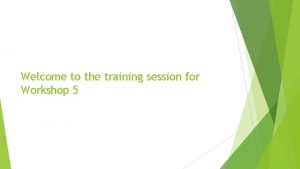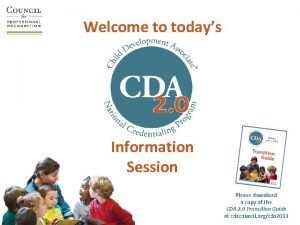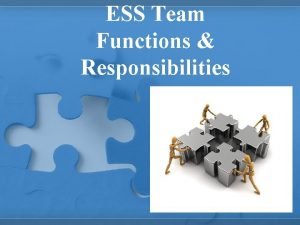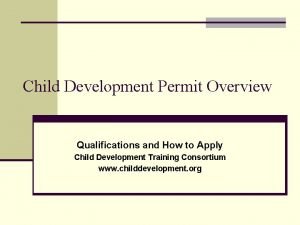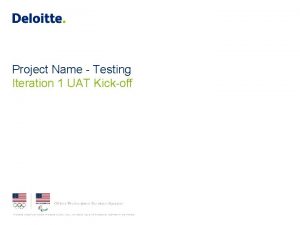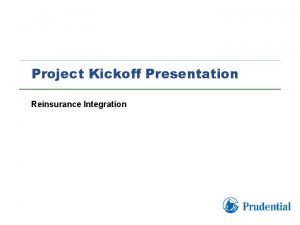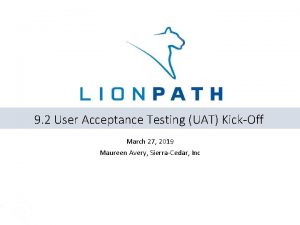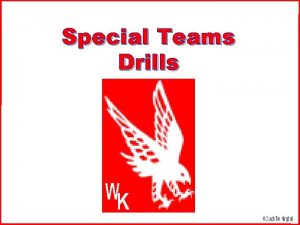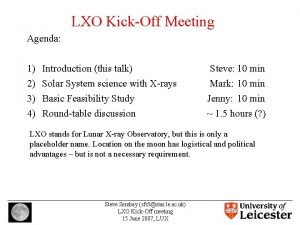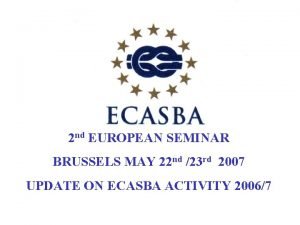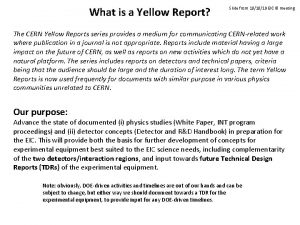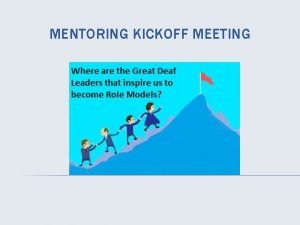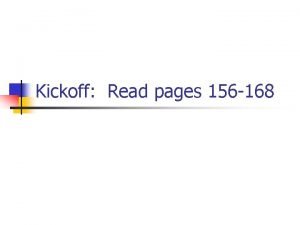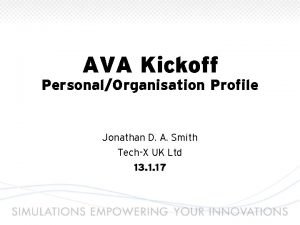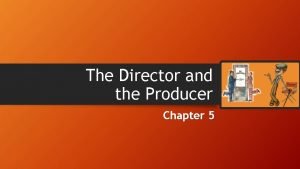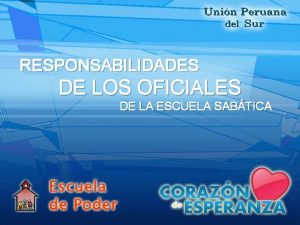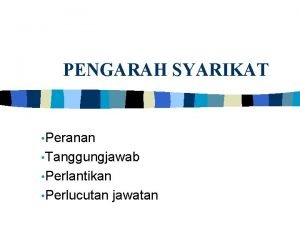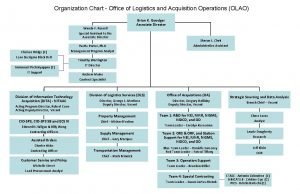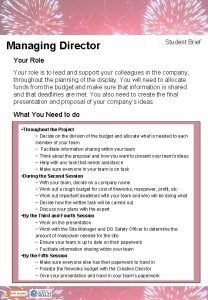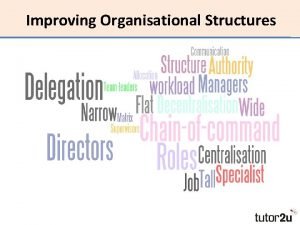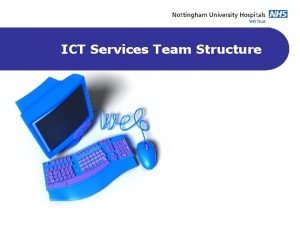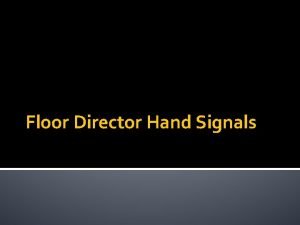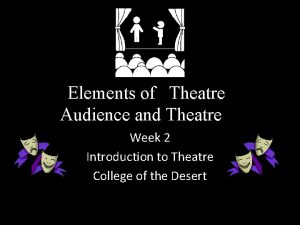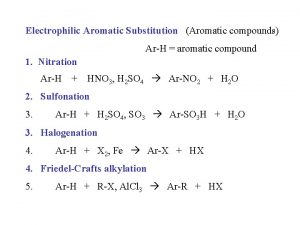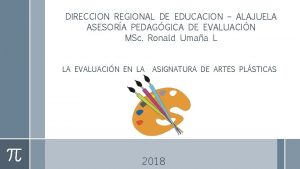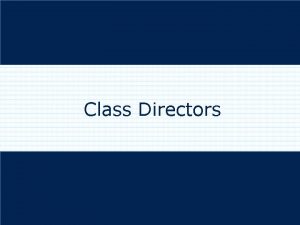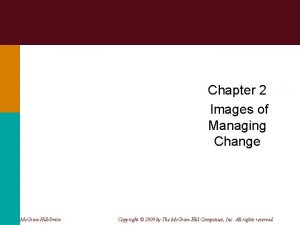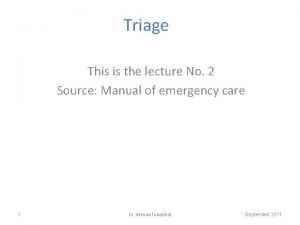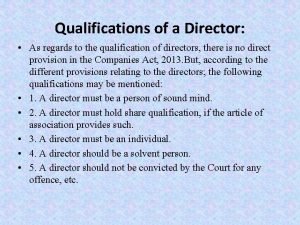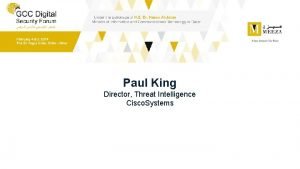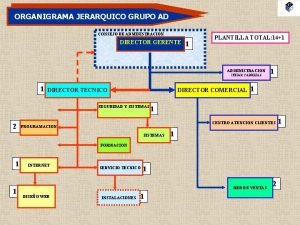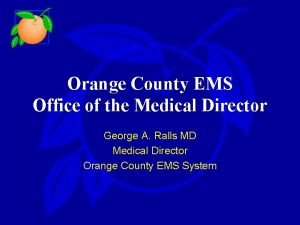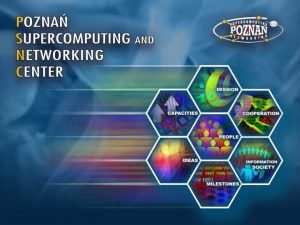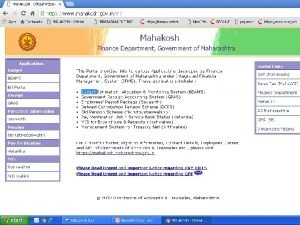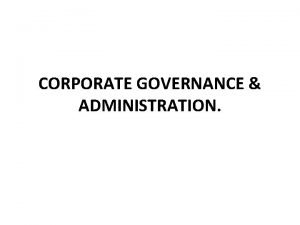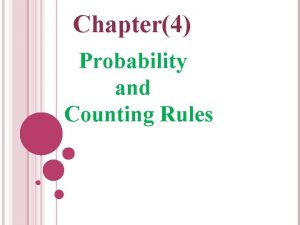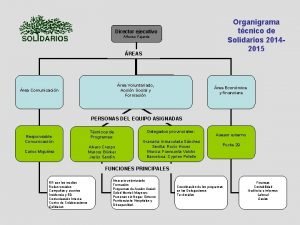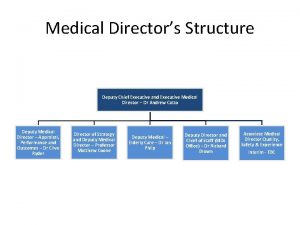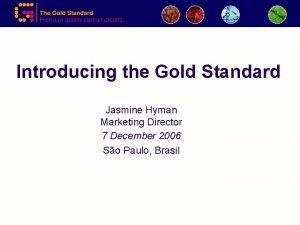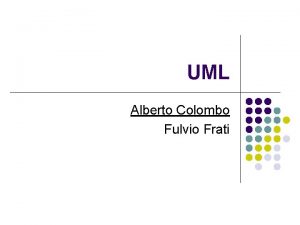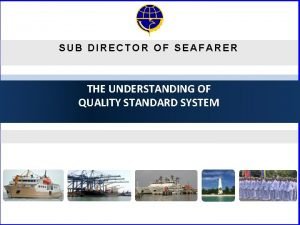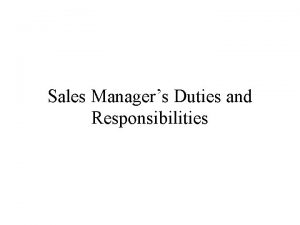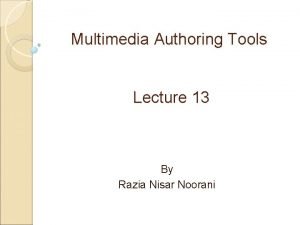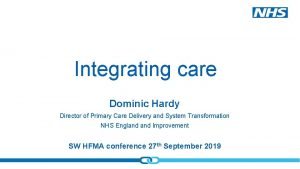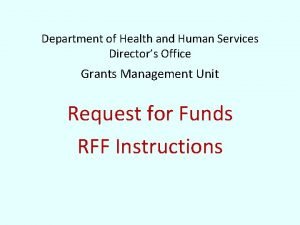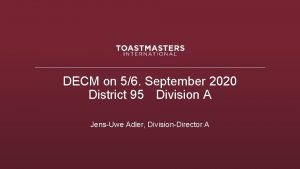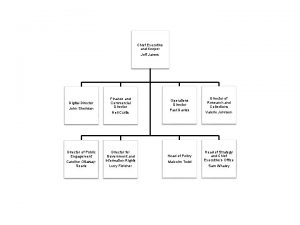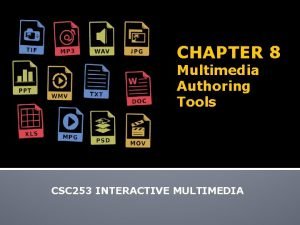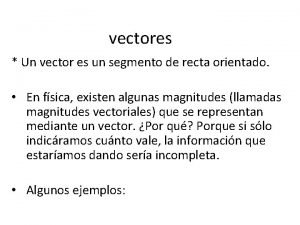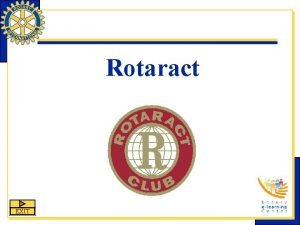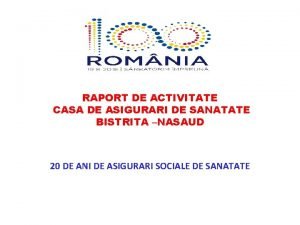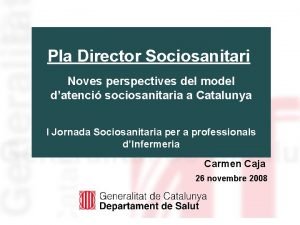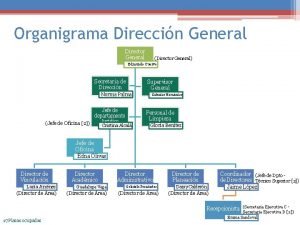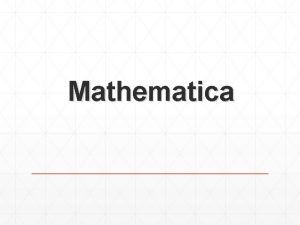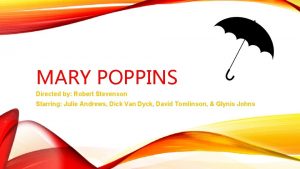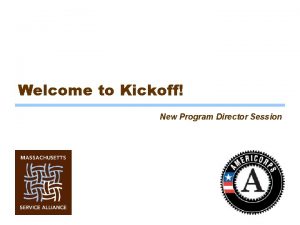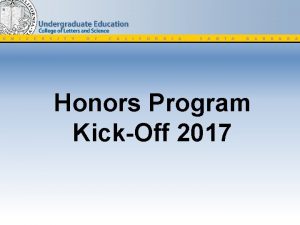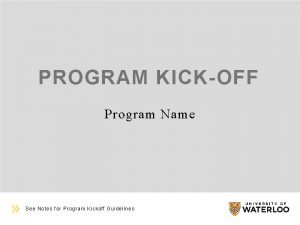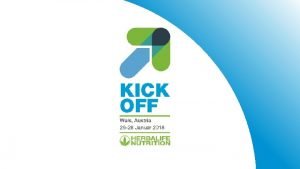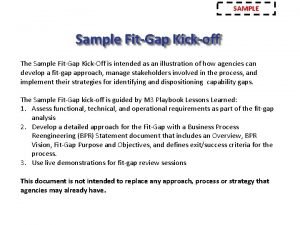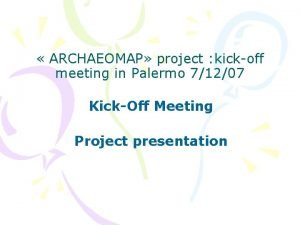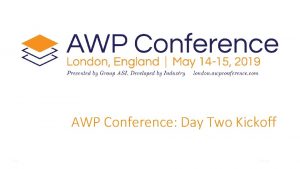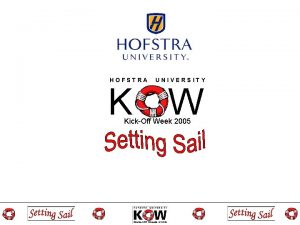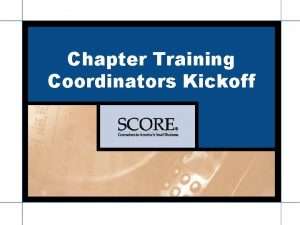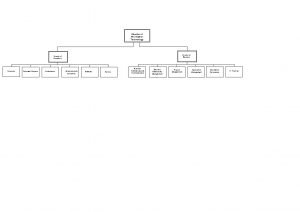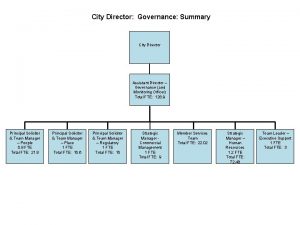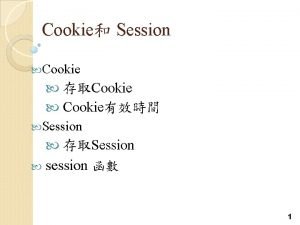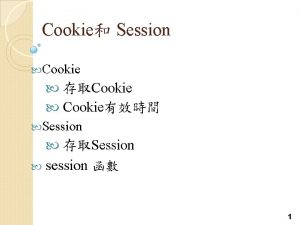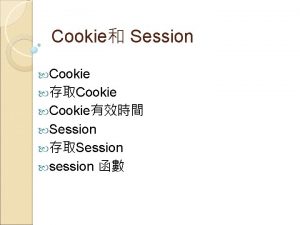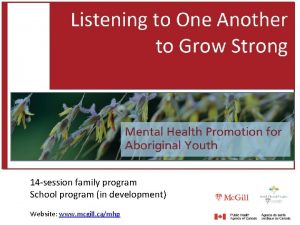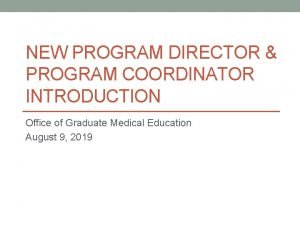Welcome to Kickoff New Program Director Session New













































































































- Slides: 109

Welcome to Kickoff! New Program Director Session

New PD Session Agenda • Introductions • Overview of National Service, Ameri. Corps, & MSA • Ameri. Corps Systems and Compliance (Systems activity, PD Handbook) • Grants Process and Management • Partnership Expectations

Overview Corporation for National & Community Service (CNCS) Massachusetts Service Alliance Ameri. Corps programs Ameri. Corps members

Written systems help programs to… • (Review) • Standardize program operations • Bring new program staff on board • Comply with Ameri. Corps Provisions • Share and replicate successful practices

Creating Systems Objective Mode Frequency What is the overall goal of this system? Describe each step of how the objective will be met. When and how often will each step described above be taken?

Creating Systems (Continued) Distribution Who will need to receive the information and/or documentation for this system? Person Responsible Who is responsible for each of the steps in your “mode” section, and who is responsible for the overall objective? Logistics Any specific details that need to be considered in order to complete the objective.

Activity! • Write a system for doing the laundry

Program Binder Requirements • Program Binders must have: • A section for each of the 2015 -16 Ameri. Corps Systems (Recruitment through Reimbursement). • A completed System Worksheet and supporting documentation for each section – For example: member application, contract, performance measurement instruments, performance evaluation tool, host site monitoring tool • Program Year Calendar (resubmitted annually)

Program Binder Due Dates • All continuing programs must update their systems and documentation annually • Resubmissions due late September (date TBA) • New programs’ binders are due per Program Officer instructions – staggered schedule focusing on start-up systems first • List of the Systems and Objectives and blank system worksheets available on our website: www. massservice. org

Grant Management

Viewing Your Ameri. Corps Grant • e. Grants • Program narrative • Performance measures – Aligned measure for primary service activity • Program Budget – Including Budget Narrative • My Ameri. Corps portal (to be covered later in Kickoff) – Member enrollment and exiting ( 30 day compliance) – Service site listing – Manage slots • My Ameri. Corps tutorials: – http: //www. nationalservice. gov/resources/americorps/myamericor ps-support-americorps-state-commissions-and-sub-granteesegrants-0

Progress Reports • Mid-year and end-of-year update with multiple components • Basic program information • Progress toward achieving Performance easures • Also an opportunity to share accomplishments and challenges • Completed online – October 15, 2016: cumulative for 2015 -16 program year – April 15, 2017: data through March 31 for 2016 -17 program year – October 15, 2017: cumulative for 2016 -17 program year

PER and Reimbursement Requests • Periodic Expense Report (PER) • Minimum quarterly – October, January, April, July – Reimbursement request no later than 30 days after submitting quarterly PER – Must submit with July 15 PER – Able to request more often; MSA recommends monthly • Reimbursement basis; no advances • Fifteen day processing time based on 15 th and 30 th of each month

Grants Process • Recompete vs. Continuations (review) • FY 2017 MSA RFP released early August 2016 – TA sessions to review instructions – Recompete concept papers due in mid- to late September • Competitive continuation applications due to MSA in Word format by early December – Application instructions will be sent by Program Officer

Partnership Expectations

Partnership • Assume positive intent • Mutually beneficial relationship • Communicate openly and frequently • Lead the service field • Use and refer to provisions to ensure compliance

Communication • Program Officers (primary contact) – – Suzana Kantardzic, Senior Program Officer Maura Hackett, Program Officer Rachel Lieberman, Program Officer Elizabeth Way, Program Officer • Other MSA Staff – – – – – July Afable, Manager of Accounting and Finance Susie Flug, Commonwealth Corps Program Manager Steve Gallucci, Chief Financial Officer Emily Haber, Chief Executive Officer Lisl Hacker, Manager of Training and Technical Assistance Shana Lothrop, Program Officer for Volunteer Initiatives Beth Mc. Guinness, Director of Programs Colin Mc. Laughlin, Administrative Coordinator Amy Mulvena, Commonwealth Corps Assistant Lindsay Rooney, Director of External Relations and Development

Activity: National Service Context • Program Director’s Handbook: Your best friend (2 min. ) – Group 1: Skim page 5 (CNCS Mission & Strategic Plan) – Group 2: Skim page 6 through 7 (CNCS Structure and Programs) – Group 3: Skim page 6 and 7 (especially “About MSA”)

National Service Context • Group Activity (7 min. ) • On flipchart paper • List five words that summarize most important information about: – Group 1: CNCS – Group 2: National Service Programs – Group 3: Massachusetts Service Alliance • List up to three: – Insights/learning about how this information relates to your role as Ameri. Corps program manager, – Questions about this information as it relates to your role.

Program Directors’ Meetings • Four required meetings annually • 2016 -2017 meeting dates: – October 19 th – December 14 th – February 15 th – May 17 th* *contingent on the Atlantic Cluster Conference dates, please also reserve May 24 th • Hosted by programs – MSA is looking for volunteers! • Mandatory program representation • Members should not attend

Ameri. Corps Opening Day • Full day event on Friday, November 4, 2016 • Roxbury Community College • Mandatory program representation • Lindsay and Emily will talk more about this tomorrow morning

Training and Technical Assistance • Contact your Program Officer with questions • Lisl and Gretchen will continue providing support • Online resources – National Service Resource Center • E-newsletters and MSA grantee page • Atlantic Cluster Conference – spring, likely in Baltimore • We will continue to talk more about T/TA throughout the Kickoff and throughout the year

Criminal History Checks Compliance, Disallowance, and Tracking

Agenda • NSCHC Requirements • Tracking Background Checks with member hours • Disallowance

Why National Service Criminal History Check (NSCHC)? • Requirements set by Congress and implemented by CNCS • Reasons for background checks: – – Responsibility to protect vulnerable populations Responsibility for taxpayer dollars Uphold the requirements based in law Cost disallowance & other consequences for noncompliance

The NSCHC requirements • Verify identity against government photo identification • Obtain written authorization from the person to perform the check • Document understanding that selection is subject to the checks • Determine the types of checks required and from where they are to be obtained; • Pay for the checks • Perform the NSOPW check before service/work begins • Initiate the criminal history information check(s) no later than the start of service/work • Provide opportunity for review of findings • Keep the information confidential • Accompany those with pending checks when in contact with vulnerable populations • Maintain the results of the checks • Document that you verified identity and conducted the required checks • Document that you considered the results of the checks.

Disqualifications • An individual is ineligible to serve in an Ameri. Corps program if they: – Refuse to consent to a State Criminal Registry and FBI Check Note: this does not include NSOPW check because it is public information, no consent is required. – Make a false statement in connection with a Program’s inquiry concerning the individual’s criminal history – Are registered or required to be registered on a State Sex Offender Registry – Convicted of murder

Who must be checked • All Ameri. Corps members must undergo checks • “Covered Staff” must also undergo checks – All staff listed on your Ameri. Corps grant budget – Includes those funded by match, listed as in-kind, or at sub-sites or national offices – Percentage on grant does not matter • Three types of checks: – NSOPW (National Sex Offender Registry/Website) – State check(s) – FBI check

Which checks are required? No recurring access to vulnerable populations: Access to vulnerable populations: ü NSPOW ü NSOPW ü State Check(s) or FBI Check ü State Check(s) ü FBI Check

Defining Recurring Access and Vulnerable Populations • Defined as people: – 17 or younger – 60 and older – Who have a disability • Recurring access: – CNCS defines “recurring access” as “the ability on more than one occasion to approach, observe, or communicate with an individual through physical proximity but not limited to, electronic or telephonic communication. ” – And adds that there is an “exemption for access that is episodic in nature or for a [one]-day period. Not regular, scheduled, or anticipated component of activities. ” • Accompaniment is required until either required state checks OR FBI check has been returned (more on that later)

NSOPW • National Sex Offender Public Registry/Website (NSOPW) – Only valid sex offender check – SORI, the MA check, is neither required nor sufficient • Check your language • All covered staff and Ameri. Corps members are required to undergo this check • Extremely easy to complete – Use NSOPW. gov – Make sure all are reporting – Verify and document results, check pictures returned

State Criminal History Registry Checks • State of Residence and State of Service/Employment check are part of this requirement – Individuals residing in MA when applying only need one (MA) check – Otherwise, two checks are required, and BOTH must be initiated before the start of service • CNCS has designated specific registries in each state and most territories – See here or a list of CNCS-designated state repositories and alternatives – Massachusetts Criminal Offender Record Information (MA CORI) is ours • Some states will not provide information or have an extremely onerous procedure – Alternative Search Procedures (ASPs) – Document, document!

State of Residence checks • State of Residence can be difficult to determine, especially for college students or those living and working in different states • Guidance from CNCS FAQ: – “the state where a candidate resides is the location that the person considers his or her place of residence at the moment in time that he or she applies to serve or work. ” – For college students “A person applying to serve or work who is enrolled full-time in college is deemed to be residing in the state where he or she lives for the purpose of attending the school… Programs may not opt to use any other basis for identifying the student’s residence state, e. g. , such as the student’s family home. ” • It can’t hurt to cover your bases and complete checks for multiple states.

FBI Criminal History Record Check • FBI checks require fingerprints to complete • In some states there is an agency, usually the state police, that serves as a repository for fingerprintbased checks • We do not have that option in Massachusetts, have to go directly to FBI (Departmental Order) or use a channeler • For the first time this year we have an approved channeler! – Fieldprint – Channeler is an intermediary between programs and the FBI – Cuts down time for check tremendously

More information about Fieldprint • Fieldprint is only for FBI checks – Average completion time is 3 -5 business days (according to CNCS) – Very helpful Fieldprint introductory webinar recorded by CNCS on You. Tube • Programs are not required to use Fieldprint – Please let us know if you plan to use the Departmental Orders (DO) process, which is the official name for when fingerprints are sent directly to the FBI

Documented Accompaniment • No unaccompanied access to vulnerable populations pending State Check(s) or FBI check – A person is accompanied when he or she is in the physical presence of a person cleared for access to a vulnerable population. – An employee or representative of a placement site may provide accompaniment if that person’s clearance was established under the placement site’s rules. • Accompaniment must be documented contemporaneously or it is not compliant – Person accompanying must be noted, as well as dates and times – Timesheets are the best place to document accompaniment

Reviewing Check Results • Must document that findings have been reviewed by program staff and considered in selection/hiring process • No matter what, murder conviction, sex-offense is disqualifying – More info in CNCS regulations and FAQ about what offenses are included • A “not clear” check is not automatically disqualifying • Organizations must have established, documented policies to determine how to deal with other offenses that might be returned on checks

Examples of Policies via CNCS Statutory Minimums Office of Juvenile Justice Delinquency and Prevention Guidelines NCMEC Child Safety Program • Refusing to undergo the process • Crimes involving children or dependent adults • All felony convictions • False statements • • • Murder Crimes of violence within 10 years* Lesser crimes of force • Sex offenses requiring registration • All other crimes discretionary based on position, circumstances, recency and other factors • Lesser crimes of a sexual nature • Controlled substances • Cruelty to animals * If utilized by a CNCS grantee, murder would render an individual ineligible regardless of the offenses’ age, due to the statutory requirements of 45 USC 12645 g.

Other Requirements • Consecutive terms: no need to re-check if service/employment uninterrupted or if a break is fewer than 120 days • All programs must have at least one staff person involved in NCHSC complete a new online training, anyone who is involved in the process should complete it • Best practice: address contact with vulnerable populations in position descriptions for members and staff • MSA requires you to track background checks along with member hours, submit to MSA periodically

New Hours/NSCHC tracking sheet for 2016 -17: Instructions

New Hours/NSCHC tracking sheet for 16 -17: General Instructions • Your Program Officer will send this with 16 -17 PER and other startup documents • Submit the spreadsheet 30 days after program start date and with every reimbursement request • Every member and covered staff-person must be listed with background check dates, including returning members and staff • There are two tabs to complete: one for covered staff and one for members • The members tab includes hours information – Note the date that hours entered are counted through

New Hours/NSCHC tracking sheet for 16 -17: Instructions for Entering Information • If a background check has not been returned, leave the corresponding cell blank or enter "not in" • When a state of residence check or FBI check is not required enter "N/A" • For the column labeled "accompaniment, " select "not required" if either: – The member/staff does not have access to vulnerable populations – The NSOPW is complete and either required state background check(s) or FBI check are complete before start of service – Otherwise, note whether accompaniment was completed/documented

New Hours/NSCHC tracking sheet for 16 -17: Helpful Information • Read instructions page, please • FBI Check initiation date: for DO, remains the same; for Fieldprint it is the date fingerprints are taken – We know this is more stringent than CNCS requires, MSA has concerns about considering a check “initiated” when member/staff may not have shown up for appointment • We will use the data you provide to calculate disallowance, so please double check information before submitting • Be kind to your PO: please do not put additional characters in cells, use the notes column instead

Consequences of Noncompliance: Risk-based Disallowance • Last year, CNCS came up with a new system for determining consequences of noncompliance – Less impact on members for programs’ mistakes – Consequences vary based on severity of noncompliance or “risk” – CNCS funds are disallowed; program cannot spend them • Disallowance Guide is technically interim, but CNCS indicated that guidance will not undergo any major revisions for 16 -17

CNCS Mitigation Matrix

Mitigation Levels in Plainer Language Mitigation Rating No recurring access to vulnerable populations Substantial On-time NSOPW AND at least one of these, even if late: • State check • FBI check All of these: • Performed accompaniment • On-time NSOPW • On-time State Check or FBI check Late NSOPW AND at least of one of these, even if late: • State check • FBI check Either: 1. On-time NSOPW and late state check or late FBI check 2. Performed accompaniment and ontime state check or FBI check Moderate Low Recurring access to vulnerable populations None of the above

CNCS Disallowance Determination NSCHC Risk-Based Disallowance Overall % of noncompliant individuals: ≤ 50% > 50% ↓ ↓ Substantial $250 $500 Moderate $500 $1000 Low $750 $1500 Mitigation Level Disallowance for each individual with:

Background Check Update Continued Compliant Members/Staff Noncompliant Members/Staff Total Members/Staff 1615 152 1767 Overall Noncompliance Rate 8. 6% Disallowance $64, 875. 00 • Disallowance Results – Only six programs with 100% compliance – Most programs had <15% noncompliance – Five programs had very significant (15 -50%) noncompliance – Three had extreme noncompliance (>50%) – Disallowance amount is taken from unexpended funds, fiscal staff should plan accordingly

Next year… 100% Compliance for 100% of MSA’s Programs!

Tools and Resources • NSCHC Clearinghouse on Knowledge Network: – http: //www. nationalservice. gov/resources/criminal-history-check • Disallowance Guide: – http: //www. nationalservice. gov/sites/default/files/resource/Interim_Disallo wance_Guide_for_Staff_and_Grantees_Updated_September_9_2015_0. pdf • Required NSCHC training: – http: //cncstraining. articulate-online. com/4240214797 • CNCS FAQ: – http: //www. nationalservice. gov/sites/default/files/resource/FAQs_Version_ 070716_1. pdf • Regulations: – http: //www. ecfr. gov/cgi-bin/textidx? ID=9 e 5466 ae 66 b 0 b 60241 f 448502 b 41433 b&mc=true&tpl=/ecfrbrowse/ Title 45/45 chapter. XXV. tpl • Instructions on how to request an ASP: – http: //www. nationalservice. gov/sites/default/files/resource/ASP_and_Exem ption_Guidance. pdf

Thank you! Any questions?

Monitoring Tools Systems and Objectives, Program Binders, Risk Assessments & Site Visit Monitoring Tools

Systems & Objectives • An Ameri. Corps System is a structured set of procedures developed to help Ameri. Corps programs: – – Standardize program operations Bring new program staff on board Maintain program continuity during staff transitions Ensure procedures and documents are compliant with CNCS and MSA guidelines – Document best practices

2016 -2017 Ameri. Corps Systems • Recruitment • Selection • Eligibility and Enrollment for Members • Tracking Member Hours • Exiting Members • Developing and Implementing Member Training • Member Supervision • Tracking, Recording and Reporting Progress • Site Partner Management • Continuous Improvement • Financial Management Systems • Documentation of Matching Funds • Reimbursement

Systems help MSA to… • Facilitate compliance with Ameri. Corps provisions • Identify specific operational challenges to be addressed through T/TA • Provide models for prospective and new programs to set up Ameri. Corps infrastructure • Share and replicate successful practices

Program Binder • Full binders are required of all programs beginning their three-year grant cycle – Program Calendar – Address all 13 systems • Program Binder Desk Review self-assessment – System checklist – Document checklist – To be submitted electronically

Program Binder • Partial/Resubmission – Programs in second or third year of grant cycle – Must complete a resubmission form indicating whether any updates or changes have been made to systems along with corresponding documents – New systems and documents may be required to bring binder into compliance

Risk Assessment • Performed annually with the Risk Assessment Form – – – Audit and Grant History Organizational and Staff Capacity Program Management Financial Management Other Risk Factors • Programs identified as low, medium, or high risk • Risk Assessment level is sent to program over the winter

Site Visit Monitoring Tools • Monitoring Systems and Objectives • Member File Checklists – Standard – Individual • Member & Site Partner Interview Questions

Prohibited Activities/Accountability • Detection – CNCS Quarterly review of position descriptions • Position description • Certification from program that members not engaged in prohibited activities – Include details of what recruited volunteers will do in member and volunteer positions* * Members cannot recruit volunteers to do prohibited activities

Member Human Resources Recruitment and Selection

RECRUITMENT. What we are looking for … • Consistent recruitment materials, that include: – Program requirements and benefits – Reasonable accommodation statements for interviews and service – Ameri. Corps logo and MSA logo – Ameri. Corps clearly defined as service • Outreach into the local communities • Outreach into diverse communities • Inviting and inclusive language and materials

RECRUITMENT. What we are looking for … • Essential functions of the position • Position Descriptions (reviewed by MSA within 30 days of the start of the program) – Detailed; outline specific activities – Unique for each member role/function – Required to show additional responsibility if providing a higher living allowance • Be specific • Ensure additional responsibilities do not include staff displacement or member management • Amount of additional allowance should be justified by additional responsibilities – Address position’s contact with vulnerable populations

SELECTION. What we are looking for … • Consistent process – Evidence of all steps of the selection process for each member – Interviews, reference checks, offer letters • Second Year Members • Policies on background checks – Completed criminal and sex offender checks – Your own policies on what will disqualify a candidate • Evidence of non-discriminatory and inclusive process – Programs cannot discriminate based on race, disability, marital/family status, sexual orientation, gender, religion, national origin, birthplace, or age. • Massachusetts Commission Against Discrimination: www. mass. gov/mcad/

Member Human Resources Eligibility & Enrollment

Ameri. Corps Member Eligibility All information pertaining to Ameri. Corps Eligibility can be found in 45 CFR 2522. 200 11 • Citizenship or Allowable Legal Status Requirement • Educational Attainment • Criminal History Background Check Requirements • At least 17 years of age at the start of service – unless the member is out of school and enrolled in a fulltime, year-round youth corps or full-time summer program • in which case he or she must be between the ages of 16 and 25, inclusive • (42 U. S. C. § 12572 (a)(3)(B)(x))

CNCS: Change in documenting citizenship • Subgrantees will no longer need to provide proof of citizenship documents in the Member File. • In 2012, the Corporation announced that the process for verifying the identity and citizenship status of individuals applying to serve in Ameri. Corps has been automated. • With the signing of the agreement, upon an individual accepting a position, the individual’s information will be automatically reviewed by the Social Security Administration within 3 business days.

MSA: Citizenship or Allowable Legal Status Requirement • To be eligible to serve as an Ameri. Corps Members, an individual must satisfy the Citizenship Requirement at time of enrollment. • I-9 form ≠ proof of United States Citizenship • A driver’s license or government-issued identification and Social Security card are not sufficient for proving United States Citizenship.

Primary documentation: United States citizen or national • A birth certificate showing that the individual was born in one of the 50 states, the District of Columbia, Puerto Rico, Guam, the U. S. Virgin Islands, American Samoa, or the Northern Mariana Islands • A United States passport • A report of birth abroad of a U. S. Citizen (FS– 240) issued by the State Department • A certificate of birth-foreign service (FS 545) issued by the State Department • A certification of report of birth (DS– 1350) issued by the State Department • A certificate of naturalization (Form N– 550 or N– 570) issued by the Immigration and Naturalization Service • A certificate of citizenship (Form N– 560 or N– 561) issued by the Immigration and Naturalization Service Additional information can be found online at: www. americorps. gov

Primary documentation: United States lawful permanent resident • Permanent Resident Card, INS Form I– 551 • Alien Registration Receipt Card, INS Form I– 551 • A passport indicating that the INS has approved it as temporary evidence of lawful admission for permanent residence • A Departure Record (INS Form I– 94) indicating that the INS has approved it as temporary evidence of lawful admission for permanent residence.

Educational Attainment • CNCS requires that Ameri. Corps members have a high school diploma or GED by the time they utilize the Eli Segal Education Award. • Members are allowed to complete classes towards their GED during their year of service to satisfy this requirement if necessary. • An Ameri. Corps member will not be eligible to utilize the Award unless they have satisfied the Educational Attainment Requirement (Sec. 2522. 200 of 45 CFR). – High School Diploma/GED – Self-certification – GED Agreement Letter

Criminal History Background Checks and Eligibility An individual is ineligible to serve in an Ameri. Corps program if they: • Refuse to consent to a State Criminal Registry and FBI Check • Make a false statement in connection with a Program’s inquiry concerning the individual’s criminal history • Are registered or required to be registered on a State Sex Offender Registry • Have committed murder Programs must be able to document: – signed statement from candidate agreeing to undergo checks – candidate’s understanding that the position is contingent on results

Eligibility and Enrollment. What we are looking for… • Eligibility documentation (in egrants within 30 days) • Contract (signed on or before the enrollment date) • Uniform selection documentation – Interview notes – Selection rubric – Essential vs marginal functions • Written documentation that the criminal background check results were considered in selecting the individual (CORI and FBI check information should be kept in separate file) • Documentation of requests for reasonable accommodation if applicable (information should be kept in a separate file) • All timesheets (signed by member and supervisor) • Member Evaluations

Member Human Resources Exiting Members

EXITING MEMBERS • ALL MEMBERS MUST COMPLETE: – Exit interview – Member evaluation – Member exit form • Keep in mind: – Member exit date coincides with the final date of service on the time sheet – Member’s total hours on timesheets and in time log matches exit form

TYPES OF EXITS (1) • For Cause – The member has dropped out of the program without obtaining a release for compelling personal circumstances from the appropriate program official; – During the term of service the member has been convicted of a violent felony or the sale or distribution of a controlled substance; – The member has committed any of the offenses listed in the program violations of conduct section; or – Any other serious breach that in the judgment of the director of the Program would undermine the effectiveness of the program.

TYPES OF EXITS (2) • Compelling Personal Circumstances – The member has a disability or serious illness that makes completing the term impossible; – There is a serious injury, illness, or death of a family member which makes completing the term unreasonably difficult or impossible for the member; – The member has military service obligations; – The member has accepted an opportunity to make the transition from welfare to work; or – Some other unforeseeable circumstance beyond the member’s control makes it impossible or unreasonably difficult for the member to complete the term of service, such as a natural disaster, a strike, relocation of a spouse, or the non-renewal or premature closing of a project or the program.

TERMS OF SERVICE • Education Award • Pro-rated Education Award • Completing hours AND completing the term of service • For all exits, you must indicate in e. Grants if you would recommend member for another term of service

EXTREME CASES • Make every attempt to have members fully complete the exit process • Keep documentation/records

QUESTIONS?

Using the My Ameri. Corps Portal To manage members, slots and sites The slides are courtesy of Springfield College Ameri. Corps Program

Enrollment: My Ameri. Corps • Log in to e. Grants: https: //egrants. cns. gov/espan/main/login. jsp • Select “Portal Home” under “View My Ameri. Corps Portal. ”

Enrollment: My Ameri. Corps • Invite members.

Enrollment: My Ameri. Corps • After completing the fields, the member will receive an e-mail with information for portal registration and the ability to complete the member portion of the enrollment form.

Enrollment: My Ameri. Corps

Enrollment: My Ameri. Corps • Since last year, CNCS is requiring all members to enroll and exit themselves in the portal, unless a waiver has been granted. Requests for exceptions must be made to your PO by August 8 th. • If you are using paper forms and enrolling members yourself, return to the S&N Workbasket after sending the invitations. Select “Pending Invitations. ”

Enrollment: My Ameri. Corps • Once the member completes enrollment they will show up in the Pending Enrollment section of the S&N* Workbasket. • Select the member’s name and approve the enrollment. • Remember: q 30 -day enrollment period q 30 -day service location entry period *S&N = State & National

Exiting Members: My Ameri. Corps • Select the member’s name.

Exiting Members: My Ameri. Corps • Select “View” next to the member’s most current term of service.

Exiting Members: My Ameri. Corps • Select “Unlock Exit Form” and clearly communicate to member that they must complete their own exit in their My Ameri. Corps portal.

Exiting Members: My Ameri. Corps • Members must complete the Exit Survey prior to being exited in the portal • Link to Survey: http: //www. nationalservice. gov/impact-ournation/evidence-exchange/americorps-memberexit-survey • Survey available 60 days before the expected completion date. Could be manually unlocked earlier

Exiting Members: My Ameri. Corps • Update the service information re: hours completed, end date, etc.

Exiting Members: My Ameri. Corps • Indicate the Education Award Status and whether the service was “satisfactory” (*this should be communicated with member)

Exiting Members: My Ameri. Corps • • Check the boxes under Certification of Service. Approve the Exit.

Other My Ameri. Corps Portal uses • • Mange members (suspensions, transfers) Manage service locations Slot conversions Viewing enrollment, retention and 30 -day compliance reports (S&N reports) • http: //www. nationalservice. gov/sites/default/files/res ource/Program-Management-State. pdf

What’s next? q The Resource Center http: //www. nationalservice. gov/resources/americorps • Includes other tutorials • Live training and registration schedule q The e. Grants Help Desk • 1 - 888 -677 -7849 • Technical Assistance • User name/Password reset assistance

Site Partner Management

Site Partner – Selection: RFP/application process • Common goals • Community need • Accessibility of site • Performance measure alignment • Understanding/knowledge of Ameri. Corps & National Service • Selection criteria Site Partner - Orientation • Group orientation • Program activities and desired outcomes • Ameri. Corps 101 • Introduction to MSA • Prohibited activities • Background check process • Review and sign MOA/MOU – Expectations/Responsibilities • Site monitoring tool and schedule • Evaluation (tools and schedule) • Ameri. Corps and MSA identification– banner or sign Site Partner - Supervision • Member training and development Ameri. Corps 101 • Member service gear • Reasonable accommodations • Frequency • Feedback tools and schedule • Disciplinary action

Required Documentation MSA looks for… • Site partner RFP and selection criteria • Signed site partner agreements (or MOUs) • Site partner orientation agenda • Ameri. Corps site partner affiliation (signage) • Site monitoring tool • Site monitoring schedule • Program feedback and evaluation tools and evaluation schedule • Plan for orienting site partners absent from initial orientation • Site accessibility

Tracking, Recording, & Reporting Progress on your Grant

Reporting systems need to… • Demonstrate evidence of the data that has been reported on the most recent progress report • Demonstrate the program is on track for collecting data and reporting and meeting stated objectives • Dedicate responsibility for your data collection

Progress Reports • Mid-year: April 15, 2017* (through March 31, 2017) • End of year: October 15, 2017* (entire program year) • Include data and qualitative information • Electronic submission with character limits • Describe progress if a measure is not yet met • Contact Program Officer if want to change performance measure OR instrument But please do so before a report is due

Performance Measures All Programs: • Set up systems to collect & report data – What is your theory for change? “Dosage” that represents success – Select test or instrument that best fits your service model – Maintain a consistent schedule and system for collecting and storing data

Performance Measures All Programs: • Contact your Program Officer for Technical Assistance – it’s what we’re here for! – We can help you: Review logic models, current measures and discuss possible changes to improve impact • Online Technical Assistance Available for National Performance Measures – http: //www. nationalservice. gov/resources/performancemeasurement/training-resources#collection (if reapplying, know there have been changes to National Performance Measures; Theory of Change Logic Models)

Continuous Improvement To ensure the program evaluates the quality of its service activities, which includes involving extensive broad-based representation from the following: • the community served • current and potential members • site partners • foundations • businesses • community-based agencies with a demonstrated record in providing services

Using evaluation results for action and improvement • You’ve completed your program evaluation, but what do the results mean in practice? How do these results translate into actions? • Take your findings and make them actionable! – Identify program components that are working well – Identify program components that need to be improved – Develop and implement an action plan for improvement

Identify program components to be improved • Pair results to the relevant research question: – – Did anything surprise you? Any interesting or confusing patterns and trends? Revisit logic model and theory of change Conduct additional analyses of the data if necessary • Decide whether or not enough evidence exists to justify a program improvement • Suggest possible improvements, actions, or changes

Developing and implementing an action plan for program improvement • Develop an action plan for implementing change – Changes may include: the program design; how a program is implemented; how services are delivered; the staff, etc. • Specify the logistics – Who will carry out these improvements? – By when they will take place, and for how long? – What resources (i. e. , money, staff) are needed to carry out these changes? – Who can be an advocate or partner in change?

Thinking about the future Evaluations pay dividends long after they are completed. An evaluation will: • Build your program’s evidence base • Contribute to a long term research agenda • Facilitate continuous improvement and develop as a learning organization
 Welcome to the new session
Welcome to the new session Welcome to the training session
Welcome to the training session Welcome to today's session
Welcome to today's session Ess
Ess Welcome to today's session
Welcome to today's session Nsa cooperative education program
Nsa cooperative education program Child development matrix
Child development matrix Meeting objective
Meeting objective Uat kickoff
Uat kickoff Wbs includes
Wbs includes Mentor meeting agenda
Mentor meeting agenda Kickoff o que é
Kickoff o que é Uat
Uat Special teams drills
Special teams drills Proposal kickoff meeting agenda
Proposal kickoff meeting agenda Design kickoff meeting
Design kickoff meeting Fast kickoff training code
Fast kickoff training code Yellow report eic
Yellow report eic Kickoff projet
Kickoff projet Mentoring kick off meeting
Mentoring kick off meeting Kickoff 168
Kickoff 168 Ava's kickoff
Ava's kickoff Wise men three clever are we
Wise men three clever are we Welcome to christmas program
Welcome to christmas program Welcome to our christmas program
Welcome to our christmas program Welcome program
Welcome program Welcome for sabbath school
Welcome for sabbath school The text-based director, also known as the
The text-based director, also known as the Responsabilidades de un director de escuela
Responsabilidades de un director de escuela Program vizita penitenciar miercurea ciuc
Program vizita penitenciar miercurea ciuc Tugas pengarah syarikat
Tugas pengarah syarikat Logistic organization chart
Logistic organization chart Director comercial turistico tenerife
Director comercial turistico tenerife Oliver stone
Oliver stone Salaam bombay! nominations
Salaam bombay! nominations Directors brief
Directors brief Director or manager
Director or manager Director ict
Director ict Emerald director usana salary
Emerald director usana salary Director hand signals
Director hand signals Fashion show staff positions
Fashion show staff positions Importance of audience in theatre
Importance of audience in theatre Ortho-para director
Ortho-para director Vestuario de teatro griego
Vestuario de teatro griego Director del pianista
Director del pianista Regional de alajuela
Regional de alajuela Director of technical education hp
Director of technical education hp Managing director message for company profile
Managing director message for company profile Director of class
Director of class Six images of change management
Six images of change management Bart cubbins
Bart cubbins Pt demographics
Pt demographics Qualification of a director
Qualification of a director Paul king cisco
Paul king cisco Organigrama ani
Organigrama ani Orange county medical director
Orange county medical director Discussion director examples
Discussion director examples Analyst hierarchy
Analyst hierarchy Juniper nms
Juniper nms Que es desarrollo profesional
Que es desarrollo profesional Vetanika maharashtra
Vetanika maharashtra Defination of director
Defination of director Chapter 4 probability and counting rules
Chapter 4 probability and counting rules Relater personality
Relater personality Kswan project director
Kswan project director Vor aerodrome checkpoint marking
Vor aerodrome checkpoint marking Director socializer relater thinker test
Director socializer relater thinker test Howard davies (director)
Howard davies (director) Director ejecutivo organigrama
Director ejecutivo organigrama Deputy medical director
Deputy medical director Actor director musician
Actor director musician Jasmine is the director of marketing
Jasmine is the director of marketing Perkas
Perkas Con ganas de triunfar director
Con ganas de triunfar director Dominance continuum
Dominance continuum Brian gordon director
Brian gordon director Elite club bonus
Elite club bonus Acrostic poem about ethics
Acrostic poem about ethics Alberto colombo director
Alberto colombo director Devil wears prada
Devil wears prada Sub director
Sub director Single window director
Single window director Sales manager duties
Sales manager duties Multimedia authoring tool
Multimedia authoring tool Kill the director ukulele
Kill the director ukulele Hardy it director
Hardy it director English comic actor and film director
English comic actor and film director Assistant director vicky
Assistant director vicky English comic actor and film director
English comic actor and film director Eft director's office
Eft director's office Redner nach mass
Redner nach mass English comic actor and film director
English comic actor and film director Jeff james director
Jeff james director Icon based authoring tools example
Icon based authoring tools example Nec managing director
Nec managing director David warren director
David warren director Vector
Vector The newsroom director
The newsroom director Professional service director in rotaract
Professional service director in rotaract Director
Director Director casa de asigurari de sanatate calarasi
Director casa de asigurari de sanatate calarasi Andrew lang director
Andrew lang director Pla director sociosanitari
Pla director sociosanitari Organigrama director general
Organigrama director general Director general organigrama
Director general organigrama 매스매티카 사용법
매스매티카 사용법 Mathew garber
Mathew garber Director
Director Director como lider
Director como lider Dr sethi bhopal
Dr sethi bhopal

